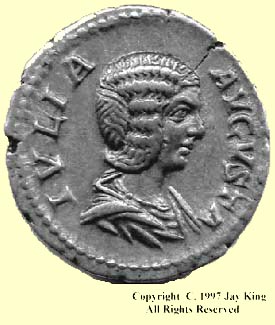 Contents -
Previous Article -
Next Article
Contents -
Previous Article -
Next Article
Julia Domna was one of the most powerful people in the Roman Empire during the period from A.D. 193 to 217. While her emperor husband, Septimius Severus, was fighting rivals, pursuing rebels, and subduing revolts in the far corners of the empire, Julia Domna was left to administer the vast Roman Empire. She proved to be an able administrator, playing one powerful general or senator against another, while keeping herself from falling into the many traps set by political enemies at court. Septimius often sought her advice, as did Caracalla when he ascended the throne after his brother's murder.. She was also a patron of the arts and invited the most brilliant philosophers, writers, and other artists in the Roman world to grace her court and keep learning and culture alive in a world that was destined to fall onto chaos within less than a generation.
Julia was a woman who was accustomed to power, but this came to an end after the murder of her son Caracalla in A.D. 217. Hers had also been a life filled with many sorrows. Caracalla had murdered his brother Geta in her private apartments even as the younger son sought protection in Julia's arms. After Macrinus had murdered Caracalla and seized the throne, he sent her away from Antioch after it was reported that Julia was inciting troops to rebel against him. At this time, she was believed to be about fifty years old and was suffering from a painful illness, probably cancer of the breast. Rather than face exile and the humiliation of being reduced to the status of a private citizen, she elected to commit suicide by starving herself.
Julia Domna's sister Julia Maesa, who later took over the role of Matriarch of the Severan household also had a profound influence on the politics of the Roman Empire during the decade following Julia Domna's death.
Even at this later date when the finest of numismatic art belonged to the past, the portraits on her coins accurately depicted her face. On the coins from early in the reign of her husband, we see the face of a strong young woman, but we see a cynical face hardened and lined with age in her later portraits. To see an image of the reverse of the coin image at the top of this page, please view the article on Fortuna in the Roman Coin Allegorical Figures, Gods, and Goddesses section.
Go to next article: on Plautilla
Go back to previous article: on Crispina